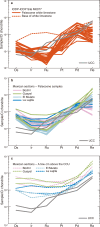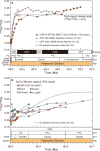Prolonged 187Os/188Os excursion implies hydrothermal influence after the Chicxulub impact in the Gulf of Mexico
- PMID: 40199849
- PMCID: PMC11978997
- DOI: 10.1038/s41467-025-58112-x
Prolonged 187Os/188Os excursion implies hydrothermal influence after the Chicxulub impact in the Gulf of Mexico
Abstract
The Cretaceous/Paleogene boundary asteroid impact is recorded globally as a negative 187Os/188Os excursion, including in sediments recovered from the IODP-ICDP drilling within the peak ring of the Chicxulub structure in the Gulf of Mexico. The reconstructed marine 187Os/188Os curves can be used for global age correlations on the ~10 kyr scale. However, the versatility of Os isotope clock between the proximal and distal sites remains unclear. This paper presents 187Os/188Os records from early Paleocene sediments deposited in the Chicxulub impact basin and Mexican sites with biochronological scales. The results for these proximal sites show a recovery timescale of ~700 kyr, which is significantly longer than that of the distal sites (~200 kyr). The interval showing the 187Os/188Os decline coincides with the enrichment of hydrothermally-derived Mn, implying that hydrothermal venting at the Chicxulub structure may have played a role in the marine chemistry and ecosystem of the Gulf of Mexico.
© 2025. The Author(s).
Conflict of interest statement
Competing interests: The authors declare no competing interests.
Figures






References
-
- Hildebrand, A. R. et al. Chicxulub crater: a possible Cretaceous/Tertiary boundary impact crater on the Yucatán Peninsula. Mexico. Geology19, 867–871 (1991).
-
- Swisher, C. C. et al. Coeval 40Ar/39Ar ages of 65.0 million years ago from Chicxulub crater melt rock and Cretaceous-Tertiary boundary tektites. Science257, 954–958 (1992). - PubMed
-
- Gulick, S. P. S. et al. Importance of pre-impact crustal structure for the asymmetry of the Chicxulub impact crater. Nat. Geosci.1, 131–135 (2008).
-
- Renne, P. R. et al. Time scales of critical events around the Cretaceous-Paleogene boundary. Science339, 684–687 (2013). - PubMed
-
- Alvarez, L. W., Alvarez, W., Asaro, F. & Michel, H. V. Extraterrestrial cause of the Cretaceous-Tertiary extinction. Science208, 1095–1108 (1980). - PubMed
Grants and funding
- JP23KK0066/MEXT | Japan Society for the Promotion of Science (JSPS)
- JP23KK0066/MEXT | Japan Society for the Promotion of Science (JSPS)
- JP23H01269/MEXT | Japan Society for the Promotion of Science (JSPS)
- FWO grant G0A6517N/Fonds Wetenschappelijk Onderzoek (Research Foundation Flanders)
- FWO grant G0A6517N/Fonds Wetenschappelijk Onderzoek (Research Foundation Flanders)
LinkOut - more resources
Full Text Sources

